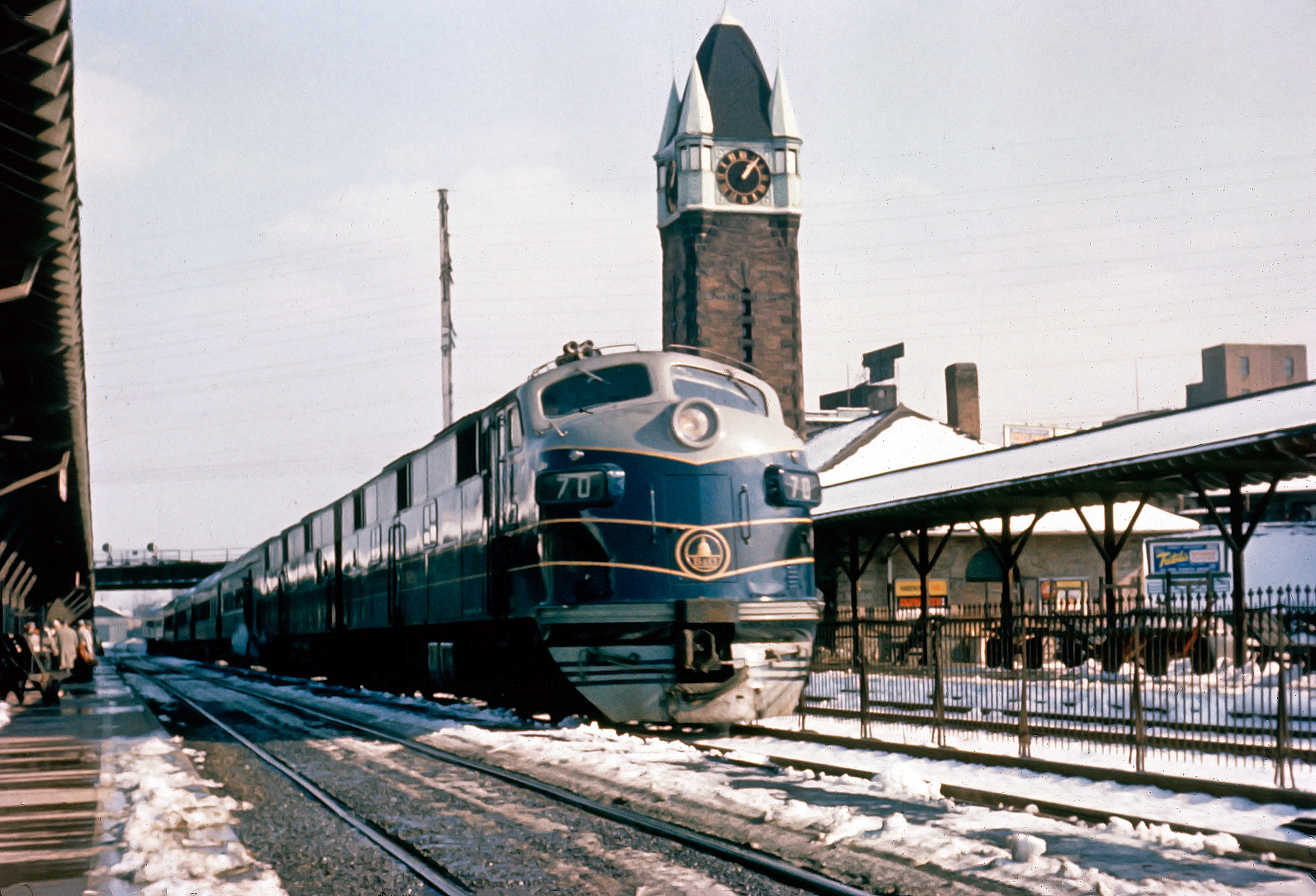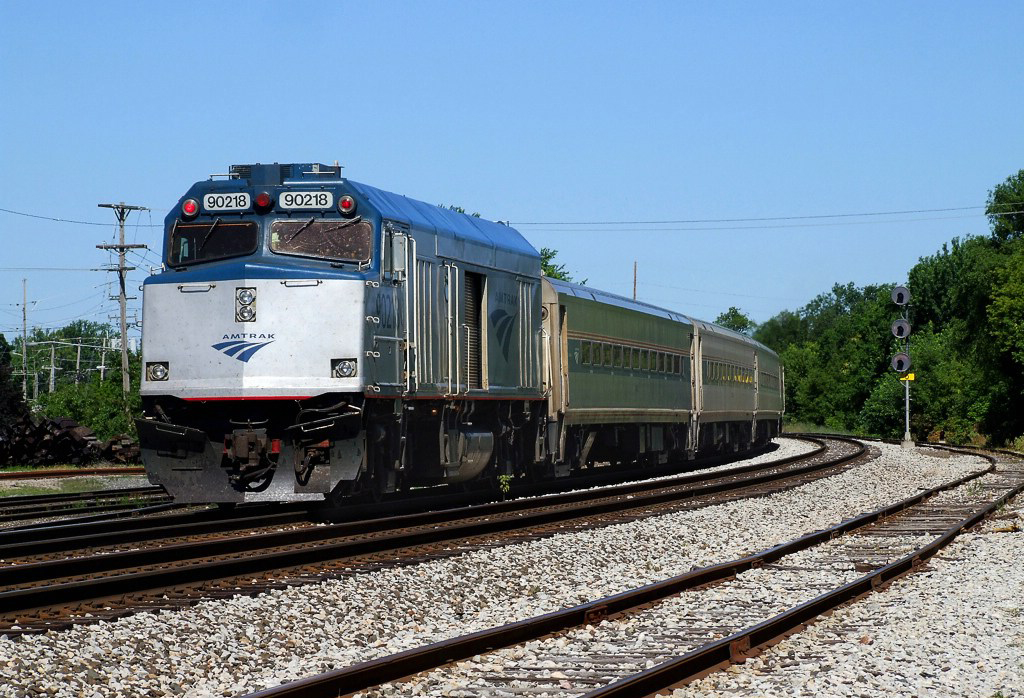EMD "E6" Locomotives: Data, Specs, Roster
Last revised: December 19, 2024
By: Adam Burns
The E6 was the last in the series the builder produced before becoming an official division of General Motors. Interestingly, it began production a year before the E5 and went on to being the most successful E-series design the Electro-Motive Corporation ever built.
Internally and externally the E6 varied little from the E5 with dual headlights and the classic slant nose. More than a dozen Class I railroads purchased the E6 with more than 100 A and B units built (in total).
With the arrival of the Electro-Motive Division's E7 in 1945, General Motors oversaw a subtle but noticeable change to the model giving it more of a "bulldog" nose that had already been applied to the FT and other early F models.
Today, two E6s remain preserved; Louisville & Nashville #770 at the Kentucky Railway Museum and Chicago Rock Island & Pacific (Rock Island) #630 at the Midland Railway Historical Society. Both units remain in their original colors and number, although neither are currently operational.
Photos
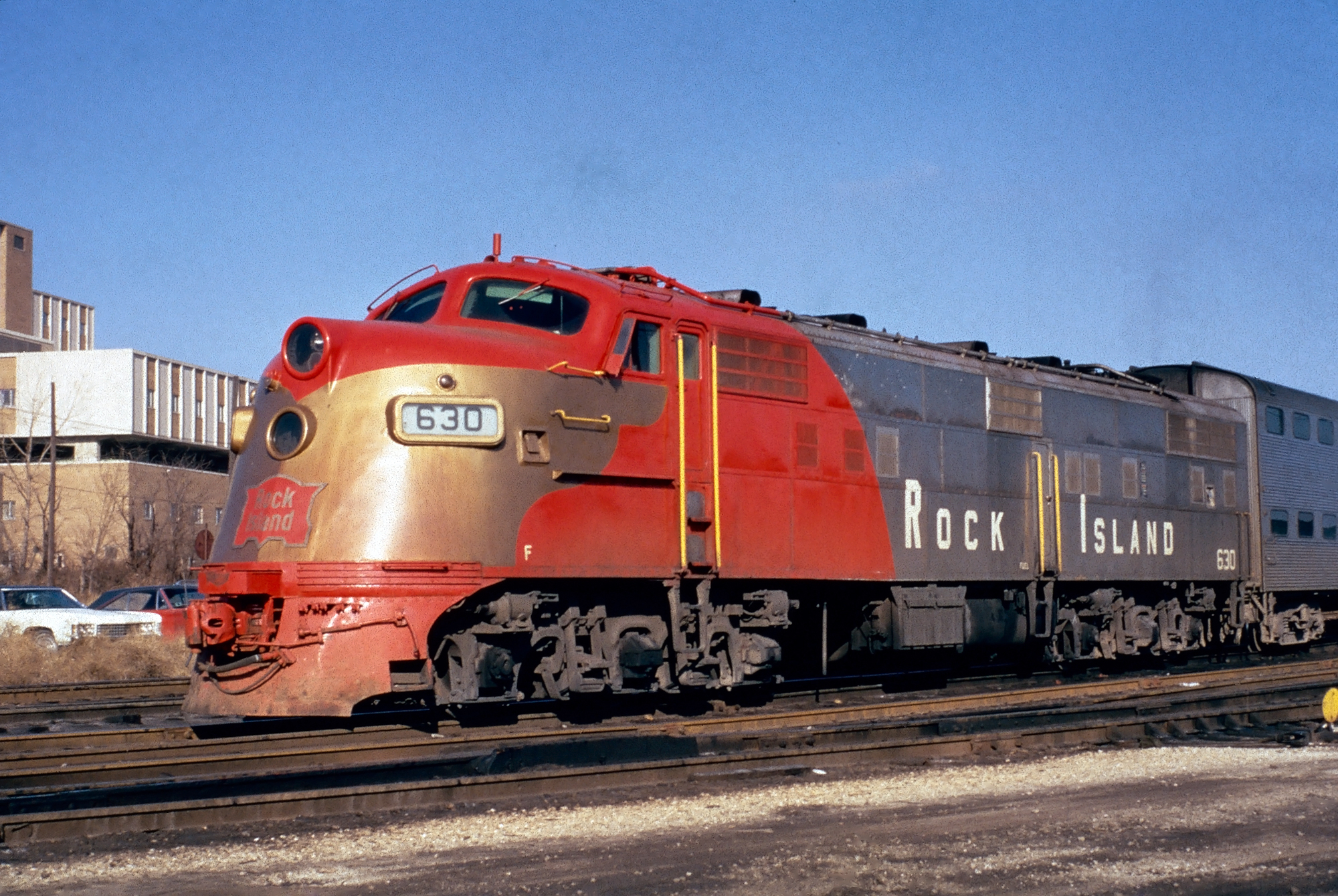 Rock Island E6A #630 works suburban service at Blue Island, Illinois, circa 1974. Robert Eastwood, Jr. photo. American-Rails.com collection.
Rock Island E6A #630 works suburban service at Blue Island, Illinois, circa 1974. Robert Eastwood, Jr. photo. American-Rails.com collection.Overview
The began production in late 1939 and was the only mass produced model Electro-Motive built before its inclusion into GM. It was virtually identical to the E3, E4, and E5 in overall appearance and internal components.
The model featured two GM-built model 567 prime movers which combined could produce 2,000 horsepower. Its A1A-A1A truck setup (whereby the inside axle was unpowered) was the same as every previous model featuring four model D7 traction motors (also built by GM).
As such it could produce 56,500 pounds of starting tractive effort and 31,000 pounds continuous (just as with all earlier models up to that time).
It also offered dynamic braking and MU capability (something that was not actually that uncommon for the time period, the American Locomotive Company's PA model also offered both).
 Rock Island E6A #631 is seen here between assignments around 1965. This locomotive spent many years in service. By this time it was generally used in either Chicago commuter service or occasionally led the "Peoria Rocket." American-Rails.com collection.
Rock Island E6A #631 is seen here between assignments around 1965. This locomotive spent many years in service. By this time it was generally used in either Chicago commuter service or occasionally led the "Peoria Rocket." American-Rails.com collection.Reception
By the time the E6 was developed, word was getting around about the reliability of EMC's early cab diesel locomotives (for both freight and passenger service) and as such, railroads began purchasing its products.
However, what truly gave the company recognition for its passenger models was actually a freight design, its FT of 1939. It toured the country showing railroads what diesels were capable of and was highly successful at doing so.
In the case of the E6 fourteen different Class Is picked up the locomotives, for use on their most prestigious passenger trains with the Atlantic Coast Line purchasing the most.
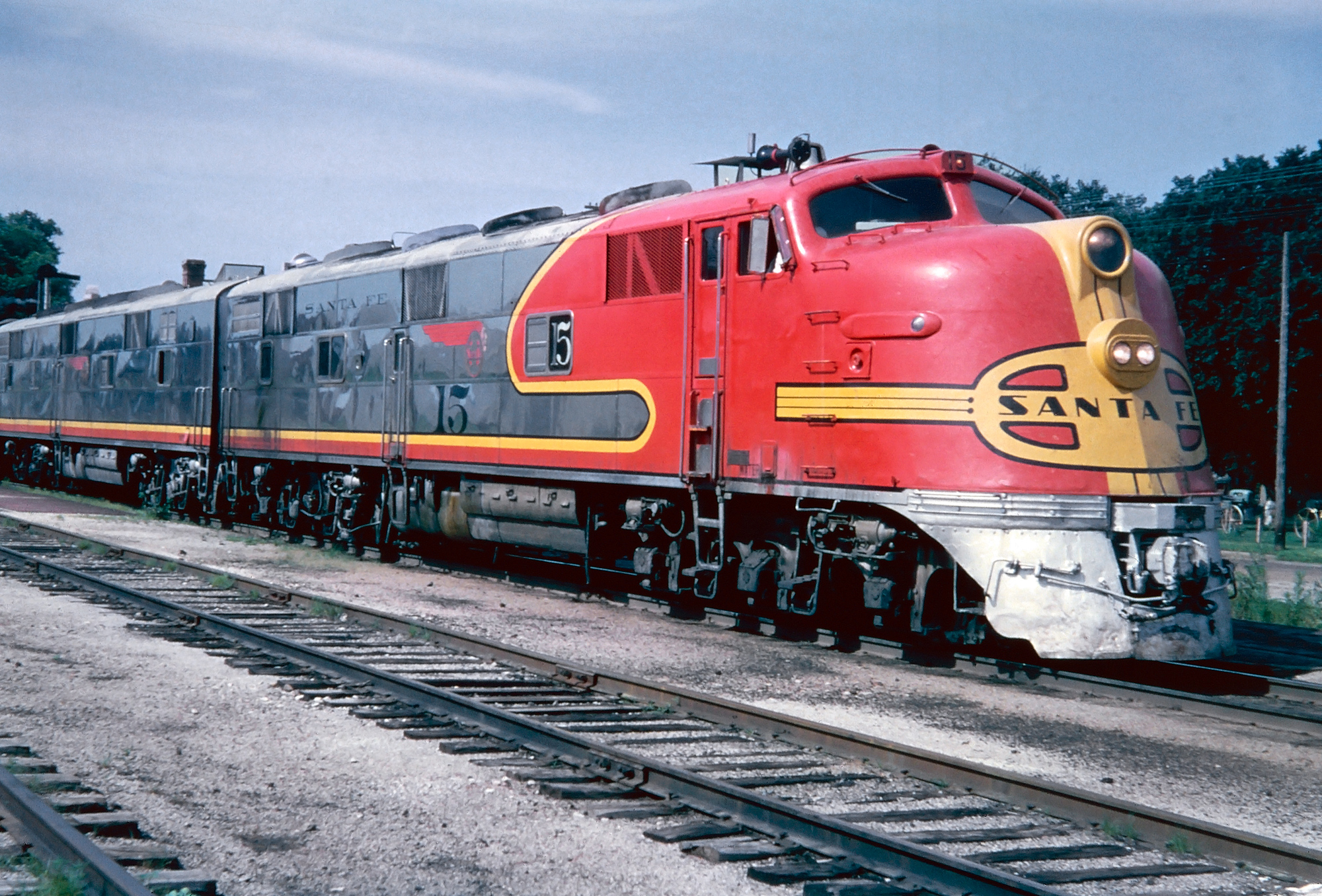 Santa Fe E6A #15-L leads what is most likely train #12, the northbound "Chicagoan," circa 1966. American-Rails.com collection.
Santa Fe E6A #15-L leads what is most likely train #12, the northbound "Chicagoan," circa 1966. American-Rails.com collection.Other lines to purchase the E6 included the Santa Fe (which had been a buyer from the beginning with the original EA model), Baltimore & Ohio, Chicago & North Western, Rock Island, Florida East Coast, Illinois Central, Kansas City Southern, Louisville & Nashville, Milwaukee Road, Missouri Pacific, Seaboard Air Line, Southern, and the Union Pacific.
EMD's one demonstrator, #1940, was later sold to the Seaboard. It should be noted that around this time the now well known railroad liveries began to appear.
This was also thanks to the Electro-Motive Division and its styling department. In the late 1930s it was headed by Leland Knickerbocker, who with the help of Sterling McDonald created the now famous Warbonnet livery.
Knickerbocker passed away in 1940 but was replaced by John Markestein who continued the work. Without these individuals and the designs they created we would not have the now classic liveries from dozens of different railroads like the B&O, Missouri Pacific, New York Central, Southern Pacific, Northern Pacific, Great Northern, Wabash, Milwaukee Road, and on and on.
Through the 1960s this department continued to create paint schemes, most of which came about to match the grace of the streamlined equipment being developed. Many railroads simply went on to adopt these paint schemes as their own and the rest, as they say, is history.
Data Sheet and Specifications
| Entered Production | 1/1940 (Demonstrator #1940) |
| Years Produced | 1/1940 - 9/1942 |
| Engine | 567 (2) |
| Engine Builder | GM |
| Horsepower | 2000 |
| RPM | 800 |
| Cylinders | 12 |
| Length | 71' 1 ¼" |
| Height (Top Of Rail To Top Of Cab) | 13' 11" |
| Height (Top Of Rail To Top Of Roof Horn) | 14' 10" |
| Width | 10' 7" (Outside Grab Irons) |
| Weight | 315,000 Lbs (A Units): 290,000 Lbs (B Units) |
| Fuel Capacity | 1,200 Gallons |
| Air Compressor | Gardner-Denver |
| Air Compressor Model | WXO |
| Air Brake Manufacturer | Westinghouse |
| Air Brake Schedule | 24RL |
| Trucks | A1A |
| Truck Type | Blomberg |
| Truck Wheelbase | 14' 1" |
| Wheel Size | 36" |
| Steam Generator Manufacturer | Vapor-Clarkson |
| Steam Generator Capacity | 1200 Lbs/Hr |
| Traction Motors | D7 (4), GM |
| Primary Generator | D4 (2), GM |
| Auxiliary Generator | Delco |
| MU (Multiple-Unit) | Yes |
| Dynamic Brakes | No |
| Gear Ratio | 52:15 |
| Tractive Effort (Starting) | 56,500 Lbs at 25% |
| Tractive Effort (Continuous) | 31,000 Lbs at 11 mph |
| Top Speed | 116 mph |
Production Roster
E6A
Total Built = 91
| Owner | Road Number | Serial Number | Order Number | Completion Date | Quantity |
|---|---|---|---|---|---|
| Electro-Motive (Demonstrator) | 1940* | 974 | E353 | 1/1940 | 1 |
| Atchison, Topeka & Santa Fe | 12-14 | 1059-1061 | E301 | 4/1940 | 3 |
| Chicago, Rock Island & Pacific | 627-629 | 1063-1065 | E305 | 6/1940 | 3 |
| Illinois Central | 4000 | 1087 | E318 | 10/1940 | 1 |
| Baltimore & Ohio | 57-59, 52 | 1091-1094 | E322 | 9/1940-10/1940 | 4 |
| Union Pacific | 7M1A-9M1A, 7M2A-9M2A | 1136-1141 | E333 | 8/1940 | 6 |
| Atlantic Coast Line | 502-515 | 1142-1155 | E335 | 11/1940-1/1941 | 14 |
| Union Pacific/Chicago & North Western | LA4 | 1172 | E341 | 2/1941 | 1 |
| Union Pacific/Southern Pacific/Chicago & North Western | SF4 | 1175 | E341 | 3/1941 | 1 |
| Florida East Coast | 1003 | 1196 | E348 | 12/1940 | 1 |
| Southern Railway | 2800-2802, 2900-2901 | 1214-1218 | E356 | 3/1941-4/1941 | 5 |
| Southern Railway | 2902-2903 | 1224-1225 | E362 | 4/1941-5/1941 | 2 |
| Atchison, Topeka & Santa Fe | 15 | 1242 | E369 | 5/1941 | 3 |
| Baltimore & Ohio | 60-63 | 1328-1331 | E388 | 6/1941-7/1941 | 4 |
| Chicago & North Western | 5005A-5006A, 5005B-5006B | 1349-1352 | E394 | 8/1941 | 4 |
| Milwaukee Road | 15A, 15B | 1363-1364 | E396 | 9/1941 | 2 |
| Missouri Pacific | 7002-7003 | 1389-1390 | E404 | 10/1941 | 2 |
| Chicago, Rock Island & Pacific | 630-631 | 1424-1425 | E415 | 10/1941 | 2 |
| Illinois Central | 4001-4004 | 1427-1430 | E418 | 12/1941 | 4 |
| Kansas City Southern | 4-5 | 1431-1432 | E420 | 1/1942 | 2 |
| Atlantic Coast Line | 516-523 | 1554-1561 | E446 | 1/1942-4/1942 | 9 |
| Florida East Coast | 1004-1005 | 1567-1568 | E449 | 2/1942 | 2 |
| Seaboard Air Line | 3015-3016 | 1593-1594 | E458 | 12/1941 | 2 |
| Louisville & Nashville | 450A-457A, 450B-457B | 1614-1629 | E467 | 5/1942-9/1942 | 16 |
* Became Seaboard Air Line #3014.
E6B
Total Built = 26
| Owner | Road Number | Serial Number | Order Number | Completion Date | Quantity |
|---|---|---|---|---|---|
| Atchison, Topeka & Santa Fe | 12A | 1062 | E302 | 4/1940 | 1 |
| Baltimore & Ohio | 57-59 | 1095-1097 | E323 | 9/1940 | 3 |
| Atlantic Coast Line | 750-753 | 1156-1159 | E336 | 11/1940-1/1941 | 4 |
| Union Pacific/Chicago & North Western | LA5-LA6 | 1173-1174 | E342 | 2/1941 | 2 |
| Union Pacific/Southern Pacific/Chicago & North Western | SF5-SF6 | 1176-1177 | E342 | 3/1941 | 2 |
| Southern Railway | 2900B-2901B | 1219-1220 | E357 | 3/1941-4/1941 | 2 |
| Southern Railway | 2902B-2903B | 1226-1227 | E363 | 4/1941-5/1941 | 2 |
| Atchison, Topeka & Santa Fe | 15A | 1243 | E370 | 5/1941 | 1 |
| Baltimore & Ohio | 60-63 | 1332-1335 | E389 | 6/1941-7/1941 | 4 |
| Atchison, Topeka & Santa Fe | 13A | 1348 | E370 | 3/1941 | 1 |
| Missouri Pacific | 7002B-7003B | 1391-1392 | E405 | 10/1941 | 2 |
| Atlantic Coast Line | 754 | 1562 | E447 | 1/1942 | 1 |
| Florida East Coast | 1051 | 1569 | E450 | 2/1942 | 1 |
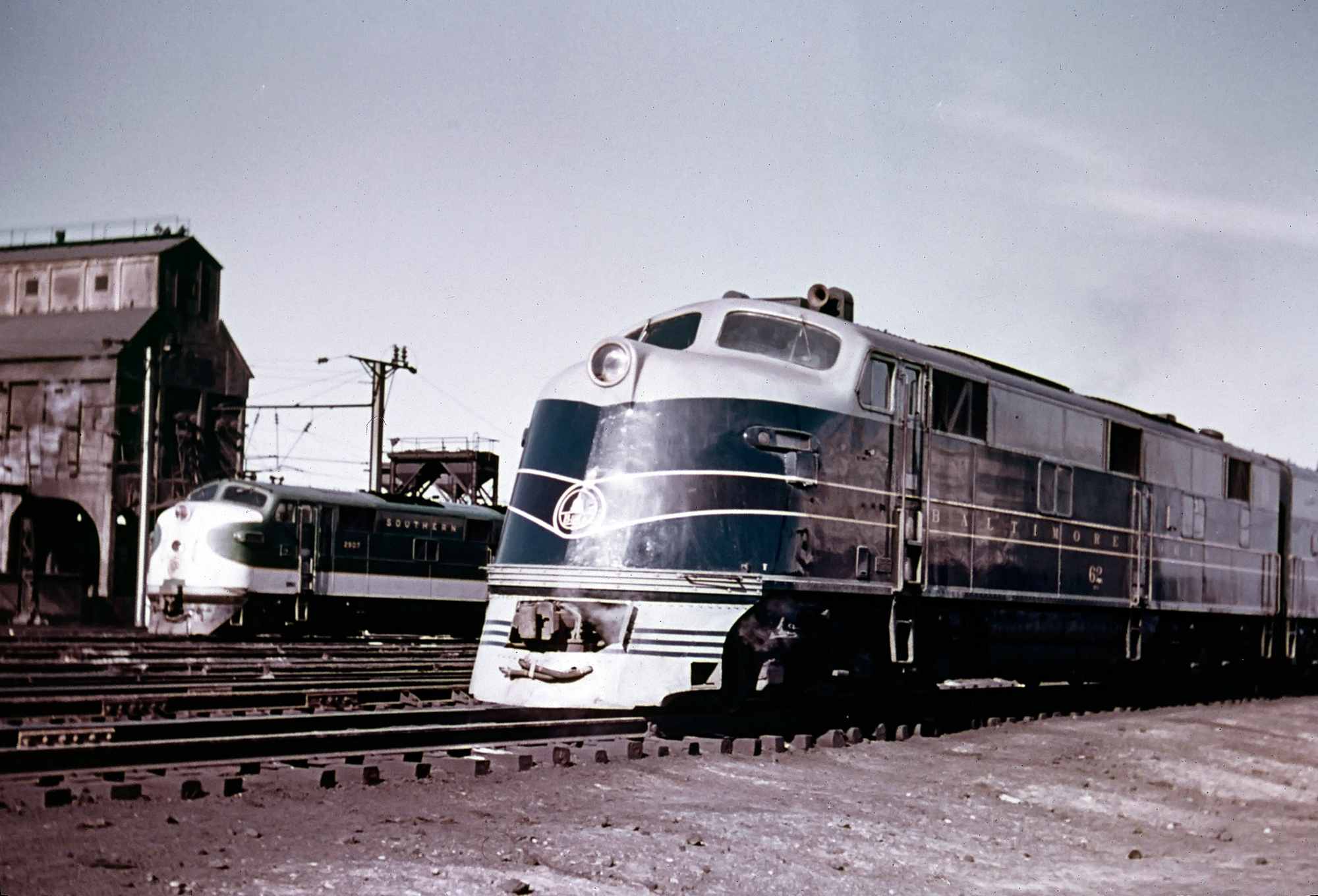 Baltimore & Ohio E6A #62 basks in the sun at the Ivy City engine terminal in Washington, D.C. during 1950. Southern Railway E7A #2907 can be seen in the background. William Rinn photo. American-Rails.com collection.
Baltimore & Ohio E6A #62 basks in the sun at the Ivy City engine terminal in Washington, D.C. during 1950. Southern Railway E7A #2907 can be seen in the background. William Rinn photo. American-Rails.com collection.In all, when production ended on the EMC E6 in the late summer of 1942 some 91 E6As and 26 E6Bs had been built, making it by far the most successful single passenger locomotive design the builder ever produced.
With the war ongoing EMD was forced to mostly halt domestic production and focus all of its efforts on winning the conflict.
In 1945, however, it resumed its E series line by cataloging the E7, which along with the E8 were the two most popular models the company would produce.
Sources
- Foster, Gerald. A Field Guide To Trains. New York: Houghton Mifflin, 1996.
- Hayden, Bob. Diesel Locomotives: Cyclopedia, Volume 2 (Model Railroader). Milwaukee: Kalmbach Publishing Company, 1980.
- Marre, Louis A. Diesel Locomotives: The First 50 Years, A Guide To Diesels Built Before 1972. Milwaukee: Kalmbach Publishing Company, 1995.
- Pinkepank, Jerry A. Diesel Spotter's Guide. Milwaukee: Kalmbach Publishing Company, 1967.
- Solomon, Brian. EMD Locomotives. Minneapolis: MBI Publishing Company, 2006.
- Solomon, Brian. Electro-Motive E-Units and F-Units: The Illustrated History of North America's Favorite Locomotives. Minneapolis: Voyageur Press, 2011.
Recent Articles
-
Guide To Amtrak/Passenger Trains In New Jersey
Apr 10, 25 09:40 PM
This guide highlights passenger train services currently available throughout the state of New Jersey. -
Rio Grande 4-6-6-4 Locomotives: Specs, Roster, Photos
Apr 10, 25 12:47 PM
The Rio Grande owned some large wheel arrangements, including the 4-6-6-4s. Interestingly, the railroad was never satisfied with these engines. -
Guide To Amtrak/Passenger Trains In Michigan
Apr 10, 25 12:06 PM
Michigan offers a variety of passenger train services, allowing travelers to discover the state's beauty and charm in a relaxed and comfortable manner. Learn more here.
